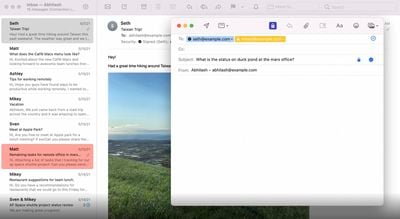macOS Monterey to Support All-New Mail App Extensions, Plug-Ins Will Stop Functioning in Future Release
As part of WWDC this week, Apple introduced a new MailKit framework for macOS Monterey that enables developers to create Mail app extensions that block content, perform message and composing actions, and help with security.

There will be four main categories of Mail app extensions, according to Apple:
- Compose: Extensions that provide new workflows when composing emails
- Actions: Extensions that apply custom rules to incoming emails, such as an email being color coded, moved to a separate inbox, marked as read, or flagged
- Content Blocking: Extensions that serve as WebKit content blockers for emails based on specific criteria in an email's HTML code
- Message Security: Extensions that sign, encrypt, and decrypt emails when sending and receiving mail, with signed and encrypted icons below emails
Xcode 13, available in beta, includes a template for developers looking to create Mail app extensions on the Mac. The extensions can be built into existing Mac apps and can also be distributed through the Mac App Store, according to a WWDC session about MailKit, which is available on macOS only and not iOS or iPadOS.
In the WWDC session, Apple indicated that older Mail app plug-ins will stop functioning in an unspecified future macOS release.
macOS Monterey is available now in beta for developers, with a public beta to follow in July.
Popular Stories
Apple will introduce new iPad Pro and iPad Air models in early May, according to Bloomberg's Mark Gurman. Gurman previously suggested the new iPads would come out in March, and then April, but the timeline has been pushed back once again. Subscribe to the MacRumors YouTube channel for more videos. Apple is working on updates to both the iPad Pro and iPad Air models. The iPad Pro models will...
In November, Apple announced that the iPhone would support the cross-platform messaging standard RCS (Rich Communication Services) in the Messages app starting "later" in 2024, and Google has now revealed a more narrow timeframe. In a since-deleted section of the revamped Google Messages web page, spotted by 9to5Google, Google said that Apple would be adopting RCS on the iPhone in the "fall...
Thieves in Montreal, Canada have been using Apple's AirTags to facilitate vehicle theft, according to a report from Vermont news sites WCAX and NBC5 (via 9to5Mac). Police officers in Burlington, Vermont have issued a warning about AirTags for drivers who recently visited Canada. Two Burlington residents found Apple AirTags in their vehicles after returning from trips to Montreal, and these...
Apple's WWDC 2024 dates have been announced, giving us timing for the unveiling of the company's next round of major operating system updates and likely some other announcements. This week also saw some disappointing news on the iPad front, with update timing for the iPad Pro and iPad Air pushed back from previous rumors. We did hear some new tidbits about what might be coming in iOS 18 and...
Photos of the first iPhone 16 cases have been shared online, offering another preview of the rumored new vertical rear camera arrangement on the standard iPhone 16 and iPhone 16 Plus. Image credit: Accessory leaker Sonny Dickson Over the last few months, Apple has been experimenting with different camera bump designs for the standard iPhone 16 models, all of which have featured a vertical ...
A $3 third-party app can now record spatial video on iPhone 15 Pro models in a higher resolution than Apple's very own Camera app. Thanks to an update first spotted by UploadVR, Spatialify can now record spatial videos with HDR in 1080p at 60fps or in 4K at 30fps. In comparison, Apple's native Camera app is limited to recording spatial video in 1080p at 30fps. Shortly after Apple's Vision ...






















Top Rated Comments
As for the mail plug-ins, they were never a great solution. Apple will continually move away from systems like mail plug-ins that live in the memory space of another application to inter-application communication systems like extensions that allow an application to extend another application visually without sharing memory space MacOS Classic style. I, for one, am looking forward to having a mail extension system that provides a stable API and that doesn’t break with each point release.
But this is also a change that needed to occur. Previously, mail bundles would break between point releases. Not major releases, mere patches. Every time Mail.app got updated, these bundles needed to get updated, too, and, until they did, the bundles wouldn’t work. Now we have a stable API guaranteed not to break on point releases and that will likely be stable across multiple major releases. We’ll probably see more mail extensions as a result of this, while previously, it was only worth the effort to devs who were absolutely serious about email extensibility. This API could also be ported to MobileMail.app, which, until now, hasn’t had any extensibility (except maybe for jailbreaking, but even then, I don’t think Mail was a common target for jailbreakers looking to tweak the system).